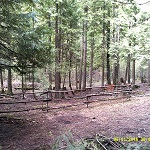Got Homestead Land? What to Do Next
Got Homestead Land? What to Do Next
 If you own land whether it be a quarter acre or one hundred acres, you can create your own homestead. The essence of homesteading is to focus on increasing what you’re able to produce yourself and reducing the number of store-bought things you consume. How you do this, to what extent, and in what order, is totally up to you and will depend on your long-term vision for your homestead. Once you have your land, here’s what to do next to use your homestead efficiently without blowing a hole in your savings account.
If you own land whether it be a quarter acre or one hundred acres, you can create your own homestead. The essence of homesteading is to focus on increasing what you’re able to produce yourself and reducing the number of store-bought things you consume. How you do this, to what extent, and in what order, is totally up to you and will depend on your long-term vision for your homestead. Once you have your land, here’s what to do next to use your homestead efficiently without blowing a hole in your savings account.
Step One: Define Your Homestead Vision
It’s really easy to get overexcited about homesteading. But if you’re not careful you’ll end up with a barn full of animals you can’t afford, an overflowing garden you can’t find time to weed, and dozens of projects in various stages of progress. Step one is to define your vision for your homestead land. What will your dream homestead look like five, ten, or even twenty years from now? You can even sketch the layout. Pretty cool vision, huh?
Step Two: Create a Homestead Plan
It’s hard to get where you’re going without first knowing roughly the direction and the path you will take to get there. If you try to homestead without a plan, you’ll find the journey is rough and you’ll never quite “get there”. So, step two is to create a homestead plan and goals based on your vision.
Now start at square one. Make a list of everything that was in your vision of your ideal homestead that you don’t have now. Did you picture a nice apple orchard? Apple trees take years to mature so planting those should go in year one. If you don’t already have knowledge about fruit trees or other crops you want, you’ll have to put research early on the list so you can arm yourself with knowledge before you get started.
Step Three: Decide What Level of Self-Sufficiency Works for Your Family
Many of us with the prepper mindset, set out to homestead with a goal of self-sufficiency, or as close to it as we can get. But self-sufficiency doesn’t come overnight. Decide what level you can reach the first year, the second, and so on until you are at the level of self-sufficiency you want. Preppers will want to focus on shelter and protection, water, food, and alternative power and keep improving those areas each year. Fresh drinking water is critical in a SHTF situation so for most preppers, digging a well, developing a spring, and/or setting up a rainwater catchment system will be on the list early in the plan.
Step Four: Start Small
Many new homesteaders make the mistake of putting in a huge garden the first year and buying several different kinds of livestock. To avoid overwhelm, start small and expand each year. Keep your garden small or portable the first year. Pay attention to your land in the first year. Which areas are wet, which get full sun, which get shade, etc.? This way when you plant your garden, put in animal pens and buildings, etc. you’ll know just where to put everything so it works best with your land.
Curb your enthusiasm for animals at first. It’s a good idea to buy one type of animal at a time.
Before you add additional types of animals, master the care, breeding, and butchering of that animal first. Get chickens the first year and learn how to care for them. You’ll have eggs and when you’re ready, meat from the older chickens. Start simple and then add other animals. This ensures you don’t blow your budget on animal care and feed in the early years as well.
Step Five: Start Learning and Mastering Skills
Focus on learning skills as you need them or before you need them. There are tons of skills to learn that can help your homestead be successful so this step will be different for everyone. Prioritize learning of skills based on what you know now and what your future goals are for each area. We’ve included the major categories below but you can choose which homesteading skills you need to master based on your personal preferences and goals.
- Money Management and Recordkeeping
- Building shelters and outbuildings
- Alternative Ways to Make Fire
- Collecting, Purifying, and Storing Water
- Renewable or Alternative Power Sources
- Gardening and Living off the Land
- Cooking, Food Preservation, and Food Storage
- Livestock Care, Butchering, and Processing
- Basic Homestead Maintenance & Management
- Security and Protection
- Personal Hygiene and Sanitation
One final tip: When constructing your home, garden, and any outbuildings or animal shelters, always build for easy expansion or repurposing later. This ensures that your homestead will be flexible if your needs or goals change several years down the road.
Got Homestead Land? What to Do Next Homestead land learning plan self sufficiency Vision


One Response
[…] Have you any idea what might come of your beautiful land. What is step number one? […]